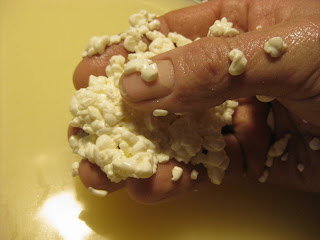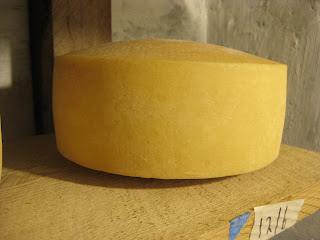
The other day someone mentioned that I probably have quite a few books related to cheese by now. Indeed, since I started making cheese last March, I have acquired quite a selection. The first one was
Ricki Carrol's book on home cheese making, which I borrowed from a friend and have yet to return. I made a few cheeses using her recipes but I soon felt very limited with the information in this book. I searched the NY public library and came across Paul Kindsted's book
"American Farmstead Cheese". Although it does not give any recipes, it is a great source with an abundance of information about all aspects of farmstead cheesemaking. A must have.
It took me a while to acquire Kosokowski's
"Cheese and Fermented Milk Foods", by many referred to as the cheese bible. It was repeatedly referenced in the Kindstedt book, but it is rather pricey. But eventually, my urge for knowlegde about cheesemaking prevailed and I ordered it. Another pricey book in the stack is
"Cheesemaking Practice" by R. Scott, R.K. Robinson an R.A. Wilbey. Rather dry but with some practical procedures in the back.
Since I started making goat cheese last fall,
"The Fabrication of Farmstead Goat Cheese" by Jean-Claude Le Jaouen and
"Goat Cheese" by the Mont-Laurier Benedictine Nuns were must haves and soon purchased. Especially the book by Le Jaouen has been very helpful.
Possibly the two publications I use the most are Margaret Morris
"The Cheesemaker's Manual" and
"Farmstead Cheesemaking Collection" by Peter H. Dixon. Margaret Morris's book describes a lot of cultures, moulds, yeasts and other ripening ingredients. It also describes the cheecemaking process step by step very clearly and has a lot of handy tips and a troubleshooting guide. Towards the end it gives recipes for both the home cheesemaker as well as the commercial producer.
Peter Dixon, a master artisanal cheesemaker in Vermont, published these newsletters a few years ago. They are full of useful and very practical information about all aspects of artisanal cheesemaking. It has quite a bit of information on cheese ripening, cultures, caves, and a good article on washed rind cheese affinage. I go back to it over and over again.
Besides books about cheese with just practical and technical information, I have also found that books describing various cheeses are very helpful in the pursue of a good cheese. Without a doubt Patrick Rance's
"The French Cheese" is the standard classic among these books. It is sometimes hard to find for a reasonable price. I did find a copy on
Abebooks of both the French cheese book as well as
"The Great British Cheese Book" at the same bookseller a while ago. It is a wonderful read which takes one through the world of French cheeses.
"The Complete Encyclopedia of Frenc Cheese" by Pierre Androuet is a handy book just to look up a cheese quickly. It describes the cheeses plainly without any pictures. The same is true for
"Cheese primer" by Steven Jenkins although this book is not limited to French cheeses.
For a more colorful guide to the french cheese, I think
"French Cheese" by Kazuki Masui and Tomoko Yamada is an excellent book. It even has some procedures for some cheeses which could be helpfull in the making of a particular cheese.
Some other books on the stack related to cheese are
"The Altas of American Artisan Cheese" by Jeffrey P. Roberts, a reference book to numerous Artisanal Cheesemakers in America, and
"The Untold Story of Milk" by Ron Schmid. The last book has convinced me that raw milk is worth traveling the extra miles for.


































